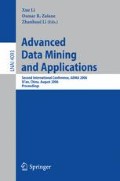Abstract
This paper introduces a novel classification method-transductive total least square classification method (TTLSC). While inductive approaches are concerned with the development of a model to approximate data in the whole problem space (induction), and consecutively – using this model to calculate the output value(s) for a new input vector (deduction), in transductive systems a local model is developed for every new input vector, based on some closest data to this vector from the training data set. The total least square method (TLS) is one of the optimal fitting methods that can be used for curve and surface fitting and outperform the commonly used least square fitting methods in resisting both normal noise and outlier. The TTLSC is illustrated by a case study: a real medical decision support problem of estimating the survival of haemodialysis patients. This personalized modelling can also be applied to solve other classification or clustering problems.
Access this chapter
Tax calculation will be finalised at checkout
Purchases are for personal use only
Preview
Unable to display preview. Download preview PDF.
References
Altman, D.G.: Practical Statistics for Medical Research. Chapman and Hall, London (1991)
Donner, A., Eliasziw, M.: A goodness-of-fit approach to inference procedures for the kappa statistic: confidence interval construction, significance-testing and sample size estimation. Statistics in Medicine 11, 1511–1519 (1992)
Gammerman, A., Vovk, V., Vapnik, V.: Learning by transduction. In: Cooper, G.F., Moral, S. (eds.) Proc. of the 14th Conference on Uncertainty in Artificial Intelligence, Madison, Wisconsin, pp. 148–155. Morgan Kaufmann, San Francisco (1998)
Golub, C.L., Van Loan, C.: Matrix computations. Jons Hopkins University Press, Baltimore, MD
Goodkin, D.A., Mapes, D.L., Held, P.J.: The dialysis outcomes and practice patterns study (DOPPS): how can we improve the care of hemodialysis patients? Seminars in Dialysis 14, 157–159 (2001)
Hsia, T. C.: System Identification: Least-Squares Methods. D.C. Heath and Company (1977)
Kasabov, N., Song, Q.: DENFIS: Dynamic, evolving neural-fuzzy inference systems and its application for time-series prediction. IEEE Trans. on Fuzzy Systems 10, 144–154 (2002)
Kasabov, N.: Evolving connectionist systems: Methods and Applications in Bioinformatics. In: Brain study and intelligent machines, Springer, Great Britain (2003)
Kukar, M.: Transductive reliability estimation for medical diagnosis. Artif. Intell. Med. 29, 81–106 (2003)
Marshall, M.R., Song, Q., Ma, T.M., MacDonell, S., Kasabov, N.: Evolving Connectionist System versus Algebraic Formulae for Prediction of Renal Function from Serum Creatinine. Kidney International 67, 1944–1954 (2005)
McKenzie, D.P., Mackinnon, A.J., Peladeau, N., Onghena, P., Bruce, P.C., Clarke, D.M., Harrigan, S., McGorry, P.D.: Comparing correlated kappas by resampling: is one level of agreement significantly different from another? Journal of Psychiatric Research 30, 483–492 (1996)
McKenzie, D.P., Mackinnon, A.J., Clarke, D.M.: KAPCOM: a program for the comparison of kappa coefficients obtained from the same sample of observations. Perceptual and Motor Skills 85, 899–902 (1997)
Neural Network Toolbox User’s Guide. The Math Works Inc., 3 Apple Hill Drive, Natrick, Massachusetts, Ver. 4 (2002)
Oja, E.: a simplified neuron model as a principal component analyzer. Journal of Mathematical Biology 16, 267–273 (1982)
Song, Q., Kasabov, N.: NFI: A Neuro-Fuzzy Inference Method for Transductive Reasoning. IEEE Trans. on Fuzzy Systems 13(6), 799–808 (2005)
Vapnik, V.: The Nature of Statistical Learning Theory. Springer, New York (1995)
Xu, L., Oja, E., Suen, C.Y.: Modified Hebbian Learning for Curve and Surface Fitting. Neural Networks 5, 441–457 (1992)
Author information
Authors and Affiliations
Editor information
Editors and Affiliations
Rights and permissions
Copyright information
© 2006 Springer-Verlag Berlin Heidelberg
About this paper
Cite this paper
Song, Q., Ma, T.M., Kasabov, N. (2006). TTLSC – Transductive Total Least Square Model for Classification and Its Application in Medicine. In: Li, X., Zaïane, O.R., Li, Z. (eds) Advanced Data Mining and Applications. ADMA 2006. Lecture Notes in Computer Science(), vol 4093. Springer, Berlin, Heidelberg. https://doi.org/10.1007/11811305_22
Download citation
DOI: https://doi.org/10.1007/11811305_22
Publisher Name: Springer, Berlin, Heidelberg
Print ISBN: 978-3-540-37025-3
Online ISBN: 978-3-540-37026-0
eBook Packages: Computer ScienceComputer Science (R0)

